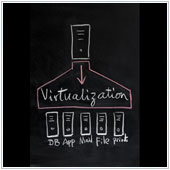Blog
 One of the most popular tech trends amongst businesses is virtualization. The common reason businesses virtualize their systems is that if it's done right, you could see substantial savings. It's quite common for a company's servers to be the first systems to be virtualized. However, while many small business owners want to virtualize, they sometimes struggle to get virtualization off the ground.
One of the most popular tech trends amongst businesses is virtualization. The common reason businesses virtualize their systems is that if it's done right, you could see substantial savings. It's quite common for a company's servers to be the first systems to be virtualized. However, while many small business owners want to virtualize, they sometimes struggle to get virtualization off the ground.
Here's five tips on better server virtualization for small to medium businesses.
1. Reality is key - It's easy, when reading about tech, to get caught up in all the new devices, ideas, etc. and maybe begin to lose site of your situation. It's not uncommon to have a small business owner want to virtualize all servers at once. This is often not feasible - budget and technology wise.
Instead, you should take the time to assess your servers and identify which servers are best suited to virtualization. For example, if the server that handles your email is starting to show its age, this may be a prime candidate. After identifying potential servers to virtualize, you can begin to develop a better plan.
2. Check compatibility - After you have picked servers for virtualization, you should look at the software the servers handle, to see if they are compatible with the virtualization software you plan to use. Should the software not be compatible you will either have to look for another solution, or upgrade the software. Fail to do this and you could face setbacks and compatibility issues which will likely cause a drop in efficiency, or even negate the savings arising from virtualization.
It is also a good idea to look at whether the server itself is capable of supporting virtualization. Each virtualization solution has different requirements and this is a good thing to keep in mind. Virtualization solutions are always advancing, so the server that can just about handle a solution now may not be able to handle it in a year or two.
3. Don't forget about your data backup solutions - Interestingly, many virtualization providers also provide data backup solutions. It may be a good idea to look at your existing backup and if it is compatible with the systems you plan to use. If not, this could prove costly for your business if something should happen where you need this.
4. R.S.S. - Reduce. Sell. Save. Server virtualization allows for many servers to be run on one physical unit. This means you will be able to reduce the number of servers, sell them, and finally reap bigger savings through decreased maintenance and operational costs.
5. Work with and IT expert - The above steps can be daunting, even to those in the IT field. There's just so much to focus on that business owners and managers often don't have this kind of time. That's why we highly recommend that in order to get the most out of virtualization, you work with a virtualization expert who can focus on helping you stay realistic, ensure the compatibility of your systems and orient your backup systems.
Looking for an IT expert to help you virtualize your systems? Why not contact us? We may have a solution to help you get even more out of your systems.
 One of the bigger tech trends of 2012 was the cloud. Browse through tech news and it's hard not to see some news piece on some form of cloud technology. While at times the media can be critical there have been lots of positive coverage about the cloud. Companies large and small are starting to realize the benefits. In 2013 you will likely see businesses increasingly migrate some, or all, of their processes to the cloud. Is your company one of these?
One of the bigger tech trends of 2012 was the cloud. Browse through tech news and it's hard not to see some news piece on some form of cloud technology. While at times the media can be critical there have been lots of positive coverage about the cloud. Companies large and small are starting to realize the benefits. In 2013 you will likely see businesses increasingly migrate some, or all, of their processes to the cloud. Is your company one of these?
Here are five things you should ask cloud service providers when looking to make the move to the cloud.
- Is your service compatible with my existing systems? As a small or medium business, you likely don't have the funds to do a one-time, full transition into the cloud. This means, that it would be a good idea to ask cloud providers if their systems are compatible with yours and if you will be able to easily migrate your data over. Beyond that, you should also ask if you can get your systems off the cloud.
- How does your data security work? Security of data in the cloud is always a top issue for all businesses. Before committing, It's a good idea to get a picture of where exactly your data will be stored, who has access to it and the level of storage security.
- What is your performance and availability? Numerous outages affecting cloud services happened in 2012. While few lasted more than half a day, this got many questioning just how stable the cloud is. When talking to cloud providers you should ask them what their uptime guarantees are and if their cloud is scalable - if you need more computing resources, are they available?
- What is your support policy? As you will likely not be hosting a cloud server in your office, you will be at the whim of the provider. It's advisable to suss out their support policy, such as whether they have a dedicated emergency contact and the general response time to issues and enquiries.
- How does your fee structure work? Finally, ask about the fee structure the provider uses. Most cloud operators offer numerous pricing schemes that companies can take advantage of.
 Virtualization is a buzzword thrown around the tech community on a seemingly hourly basis. From the outside looking in it seems that everything is, and has to be, virtualized these days, and if it isn't you're lagging behind the times. This has led to somewhat of a craze, that can be quite confusing at times. One of the more popular forms of virtualization that has got many experts talking is the somewhat confusing issue of server virtualization.
Virtualization is a buzzword thrown around the tech community on a seemingly hourly basis. From the outside looking in it seems that everything is, and has to be, virtualized these days, and if it isn't you're lagging behind the times. This has led to somewhat of a craze, that can be quite confusing at times. One of the more popular forms of virtualization that has got many experts talking is the somewhat confusing issue of server virtualization.
Here is a brief overview of server virtualization, when you should use it and what you should look for in a virtualization solution.
What exactly is server virtualization? In a nutshell, server virtualization is the practice of taking physical servers and digitizing them into virtual ones. In truth, this isn't a fully virtual solution; your servers will continue to be on a physical server, just in virtual format.
Modern virtual solutions run multiple systems - commonly called instances - on one existing server. Traditionally, servers were inefficient especially when it came to use of physical resources and hardware - much was left under utilized. Virtualization ensures that use of physical resources and hardware are maximized, leading to users getting better value from servers.
This stacking of existing systems onto a smaller number of systems decreases acquisition and overhead costs - maintenance and power - while increasing the amount of physical space available for other functions including room to grow.
Virtualization is largely made possible due to increases made in technology. For example: A server with four processors costs about 1/10th of what it did a decade ago, and is more powerful. More power and cheaper cost has given companies of all sizes the capabilities to virtualize.
When should I employ server virtualization? Virtualization is ideal for functions that are small to medium scale, ie., most simple or day-to-day business functions. If you have applications that are resource intensive and rely on more than one or two servers to be able to run, then it's probably safer to not virtualize that particular service.
Most companies will run physical servers with virtual solutions to a maximum of 50% CPU usage during peak operations. If you have multiple servers running applications that, at peak, only use about 5% of the server's power, these would be ideal to virtualize - you could virtualize up to 10 physical servers.
If an application uses 48% of available computing power at peak usage, it's probably not the best candidate for virtualization as it will cause other instances on the same server to run slower, thus negating any advantages gained from virtualization.
What should I look for in a virtualization solution When looking for a virtualization solution many companies will have different needs that they need to take into account. There are three factors that almost every company should be aware of when shopping for a virtualization solution:
- It's not 'all-in-one' - This seems to be an increasing demand of many clients; they want one system or server to take care of everything. This is not a good idea, as if something happens to the server all of your systems could be rendered useless. The best solutions take steps to ensure your solutions are redundant. That way if one fails, or needs to be fixed, it can easily be switched to the other with no loss of service.
- There's a migration solution - Most businesses, especially small to medium enterprises, will likely be looking to migrate servers from a physical to virtual (P2V) solution. This can be a time consuming experience for the uninformed. Therefore, a good service will have P2V migration tools or options to help make the transition as smooth as possible.
- The service is supported - Due to the increasingly complex nature of virtualization, good services should offer support. The best services should be able to manage your whole virtualization solution, including installing patches and updates and prompt service. They should also be able to work with your existing licences and ensure you're not paying extra, meeting your licensing needs.
 The job of a manager and entrepreneur requires an investment of serious time. You’re never focused on one task, rather you’re trying to focus on every job that needs to be done, yesterday. Sometimes you’re pulled in so many different directions that you can feel ineffective. One way to lessen this is by taking steps to hire an assistant, not just any assistant, a virtual assistant.
The job of a manager and entrepreneur requires an investment of serious time. You’re never focused on one task, rather you’re trying to focus on every job that needs to be done, yesterday. Sometimes you’re pulled in so many different directions that you can feel ineffective. One way to lessen this is by taking steps to hire an assistant, not just any assistant, a virtual assistant.
A virtual assistant (VA) fills the role of a traditional assistant but is just not physically present. Many roles, like replying to trivial emails, finishing presentations, writing or even answering your phones, can all be done through the computer. If you’re interested in virtualizing your assistant here’s five steps that will help you find the perfect assistant.
Step 1: Think about tasks you don’t like You’re not a superhero, there is always something, maybe many things, that you don’t like doing. Over the course of a week jot down what you do each day and whether you like/dislike the task. Beyond that, if you think someone could do it better, jot that down as well. At the end of the week, look over the list and see if you have to do the tasks yourself, or if you can outsource them. The tasks you can outsource can be given to your VA.
Step 2: Look for a VA Once you can justify a VA, start looking for one. Reach out to your network and see if your colleagues have assistants, and if they can provide you with a recommendation. Beyond that, consulting with organizations like the ivaa.org can return some great VAs.
Step 3: Screen candidates This step is just like hiring a physical candidate. You need to go through your list of potential hires and ask them questions to ensure they are both a good fit and what you're looking for. Some things you could ask include:
- If they have experience in the tasks you listed above.
- If they have time available to actually take on your requirements.
- Their working hours and holiday requirements.
- The services they do/don’t provide.
- Their rates.
- Their general experience.
- If they can provide references and previous examples of their work.
Step 4: Baby steps Like learning to walk, you can’t start at a run, rather you have to take it slow. Start with a small project to test the waters as a way to vet the candidate. Be sure to let them know that this is a test, and not a final offer. This won’t be free, you should pay them at their normal rates.
Step 5: Onboard slowly, terminate quickly If the VA is a good fit, and the test project goes smoothly, you can start to wrap up. Generally, the onboarding process should be slower than a normal physical hiring as you have to invest more and vet them more carefully. If you find that down the line, the VA just isn’t working out, or keeps making the same mistakes, cut them loose. A VA isn’t like a normal employee, you shouldn’t have to invest thousands of dollars and man hours training them and as such, it isn’t as much of an investment.
If you’d like to learn more about virtualizing roles or services within your company, please contact us.
 One of the more popular trends companies are adopting is virtualization, moving from physical systems to cloud/server based systems. Desktop virtualization, the act of moving your desktop computers from a physical to virtual environment is a type of virtualization that’s gaining more popularity. When it comes to this trend though some companies are apprehensive about how secure virtual environments are.
One of the more popular trends companies are adopting is virtualization, moving from physical systems to cloud/server based systems. Desktop virtualization, the act of moving your desktop computers from a physical to virtual environment is a type of virtualization that’s gaining more popularity. When it comes to this trend though some companies are apprehensive about how secure virtual environments are.
In general, you can do nearly everything on a virtual desktop that you can do with a physical desktop. The majority of office oriented software now has versions that operate in the cloud, or give administrators the ability to install the program on one machine and license it out to other machines.
The largest difference between the two systems comes in the form of security. Virtual desktops are susceptible to the exact same security issues as their physical counterparts, but they also have a few extra potential problems which are unique to virtual machines. The biggest security issue with virtual desktops comes in the form of access. With physical machines, you can lock an office door which will usually prevent people from physically accessing the machine. With virtual machines you are not able to do this. Anyone with access and a password can get onto the machine.
While this may sound like a deterrence to the adoption of virtual desktops, users should be aware that vendors are aware of this issue and have adopted measures to ensure their products are safe. In fact, if implemented properly, virtual desktops are often safer.
To ensure safety of data and machines virtual desktops need to be implemented in a specific manner. For example, some solutions will create a new environment every time you need to access a different system. This is like starting with a blank slate, with unnecessary data being deleted when you log off. Users won’t be able to customize their workspace, but it can help stave off problems of errant downloading, or installation of unnecessary programs.
Other systems allow users to customize their workspace, but save the changes in a separate location when the user logs off. This keeps any changes made to the base system easy to keep track of, and it’s easier to spot security problems, while keeping them local.
If you’re looking into virtualizing your office’s desktops, we strongly recommend you work with an experienced IT partner who can help deploy a system that meets your needs, while remaining safe. We can help with virtualization, so why not give us a call?
 Facebook has gone through many changes since it was first introduced. Now it’s one of the main communication tools for both people and businesses alike. The way most communicate is through “posts” that other people can see and comment on. The problem with posts is the amount of users that see the post is often limited. Recently Facebook introduced a new feature to help improve the exposure of your posts.
Facebook has gone through many changes since it was first introduced. Now it’s one of the main communication tools for both people and businesses alike. The way most communicate is through “posts” that other people can see and comment on. The problem with posts is the amount of users that see the post is often limited. Recently Facebook introduced a new feature to help improve the exposure of your posts.
The feature is called “Promote” and aims to give businesses a way to increase the reach of their posts. Think of it as a simplification process: instead of having to go through the ad dashboard to create an ad, it can now be done with one click.
The idea behind the promote button is to turn posts on your Page into ads that show up on a user’s News Feed - the area where posts are viewed - instead of in the ad bar, which is located on the right hand side of the page. This will, in theory, help your promotion or information reach more users while making marketing and advertising easier.
When you create a post, you can press the Promote button, located at the bottom of the post window. A pop-up window will appear giving you options. As this is a form of paid advertising, you pay to reach a guaranteed number of users. When you enter an amount to pay, (USD 5.00 is the lowest amount), you’ll be given the approximate number of fans the post will reach. You’ll also be able to target demographically and geographically. The post will be promoted for three days.
Once the promotion campaign has started, you’ll be able to view how effective the promotion is by going to your Page timeline and hovering over the numbers at the bottom of the promoted post. You’ll also be able to see how many users the post has reached, and how they viewed it. A useful tool to tell if the Promote feature is actually working.
At this time, the Promote feature is available for Page owners located in the US with more than 400 followers, and should be rolled out to all Page owners in the near future. If you’d like to learn more about the Promote feature, or other ways you can utilize Facebook as a marketing tool, please contact us.
 Virtualization. Many business owners know exactly what it is and what their companies are doing in regard to it. Whether your company has virtualized some or all of your business, it’s evident that there are cost savings. A recent report found that some organizations have achieved up to 269% return on investment from the process. Read on to learn how.
Virtualization. Many business owners know exactly what it is and what their companies are doing in regard to it. Whether your company has virtualized some or all of your business, it’s evident that there are cost savings. A recent report found that some organizations have achieved up to 269% return on investment from the process. Read on to learn how.
What is Virtualization? Virtualization is the creation of a virtual computing environment, where one hardware system can run multiple virtual environments. Common types of virtualization include servers, storage devices, or networks. The benefits of virtualization include lower costs, improved IT management, and reduced energy consumption.
The Survey A report published by CDW-G focuses on government organizations in the United Sates. Many SME owners and managers like yourselves are probably asking, “How do study results involving the government help my business?” Well, if you look closer you can see that what the government organizations did can easily be replicated by SMEs, just on a smaller scale.
Results In recent years, many companies have had to tighten their belts due to economic difficulties. Government agencies are no exception. The results of the survey found that agencies and organizations realized investment returns as high as 134 to 269%. The survey found that if IT managers invest in Server Virtualization, Document Management, Storage Virtualization, and Cloud Computing in that order, the returns on Server Virtualization alone can help pay for, if not totally cover the cost of, the other three processes. CDW-G found that on average, the total cost of implementing all four separately is over USD 1.1million, but when implemented in order, the average cost was around USD 400,000.
While it is unlikely that SMEs will see a return on investments of this magnitude, it is highly likely that they will see increased returns if they follow this method of re-investing returns from Server Virtualization into the other three steps. In times of economic stress, this could be a huge boost to your bottom line.
Helpful Recommendations From the results, CDW-G offered some useful recommendations that all businesses can use:
- When budget cuts are needed, first look for ways to increase efficiency without service cuts.
- Review technologies and processes to identify inefficiencies.
- Consider savings and efficiency opportunities in all new solutions.
- Leverage available savings into new projects.
 Desktop Virtualization is starting to gain the attention of more and more businesses with its promise of simplifying IT management, strengthening IT security, and ultimately gaining new efficiencies and cost savings in the business. Read on to find out how.
Desktop Virtualization is starting to gain the attention of more and more businesses with its promise of simplifying IT management, strengthening IT security, and ultimately gaining new efficiencies and cost savings in the business. Read on to find out how.
There is growing interest in Desktop Virtualization with its promise of improved manageability, security and efficiency for the business. Simply put, Desktop Virtualization is new technology that separates the system software such as the operating system and applications from the underlying hardware.
Desktop virtualization allows the hardware, like a laptop or a server, to run multiple operating systems. Imagine having your Mac running Microsoft Windows and Office, or your Dell running OS X and GarageBand for example. To stretch the concept even further, operating systems and applications can be housed on remote machines – such as a server farm in Texas – which you access via the web. The applications are not resident on your computer at all.
Desktop virtualization shifts the burden of managing the system software from you or your in-house IT teams to someone else—people who can do a better job managing and updating your Windows and Office software than you can. If you have a fairly large organization managing a large number of machines, centralizing support allows the organization to gain from economies of scale—ie less people to manage more machines at less cost. Leveraging the computing power of server farms with faster machines also allows employees to get more value out of aging desktops and laptops.
Enabling anytime, anywhere access to applications and data, Desktop Virtualization connects your employees to the tools they need no matter where they are. As organizations support more and more remote employees, using desktop virtualization technology gives them access to their Windows desktop anywhere in the world, at any time, on any device.
Are you supporting remote workers or is your hardware slowing down your employees? Let's talk about Desktop Virtualization and how you can try it for your organization today.


